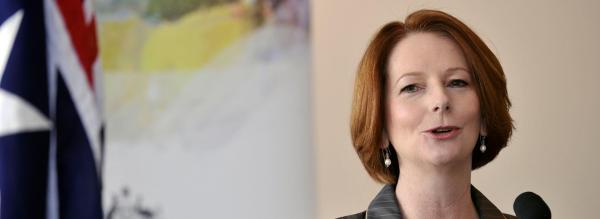
The Gillard years – measuring the impact of women leaders on women’s lives
Many people would have heard the phrase ‘justice is blind’, but looking at laws through a gendered lens could actually take us a step closer to true gender equality, says Social Impact Grant recipient and UTS law Senior Lecturer, Ramona Vijeyarasa.

Dr Ramona Vijeyarasa,
Senior Lecturer
Faculty of Law
Profile page
Gender equality in Australia has a long way to go.
According to the Australian Human Rights Commission, one in two Australian women have experienced sexual harassment, one in three sexual violence, and the bulk of women have the odds stacked against them when it comes to achieving wage parity – on average, female workers earn 15 per cent less than their male colleagues.
Worldwide, there are currently 24 women leaders occupying the highest level of elected office, but the role of female leaders in achieving better outcomes for women is not well understood, either here or overseas, says Ramona.
Nor, she says, does domestic law properly incorporate the commitments countries have made in international treaties.
While family and workplace law are often taken as the natural place to start when it comes to measuring legislation’s impacts on women, it’s not only these ‘usual suspects’ the project was interested in, she says.
‘We need to bring a woman’s rights perspective to every area of law. Yes, women face many gender-specific vulnerabilities – think sexual harassment at work, or being paid less than men for the same work. But the idea was to create a tool that would actually help to make laws rarely thought about from a woman’s rights perspective work more effectively for women, from laws that govern taxation through to the mining industry and financial services.’
Measuring countries against global standards – the Gender Legislative Index
The Gender Legislative Index is designed to determine which legislation works most effectively to promote gender equality. To do so, it scores laws against criteria for women’s rights set down in the UN Convention on the Elimination of all Forms of Discrimination against Women (CEDAW).
Originally created by Ramona to measure the impact of female presidents in the Philippines, Indonesia and Sri Lanka, it was expanded in 2020 with funding from the Centre for Social Justice & Inclusion to include Australia.
‘When evaluating laws, global standards provide a universal basis against which to measure the law, a universal target. Importantly, they remind us that every country can do better. The Gender Legislative index is one way to hold lawmakers to those standards,’ says Ramona.
Australia signed up to the CEDAW in August 1983 but when it comes to translating women’s rights principles into laws that change women’s lives for the better, there’s still some way to go.
‘Dad and Partner Pay came in during Gillard’s tenure, which provides two weeks of paid leave for dads and same sex couples. While that is progress, the two weeks puts us well below the OECD average for ‘dad pay’ – 8.4 weeks in 2018,’ says Ramona.
However, the index also found positive developments that came out of the Gillard government’s legislative agenda, including measures to better protect women in the workplace and to ensure fair pay for clothing, textile and footwear workers, who are predominantly women.
The spirit of the times
There’s no question that 2021 has been a watershed year when it comes to raising public awareness of gender issues in Australia – from the appointment of Grace Tame as Australian of the Year to the protest in Canberra on March 4 addressed by Brittany Higgins, the issues raised by #MeToo have only gathered steam.
‘The last few months have brought so much visibility to the issue of gender inequality in Australia,’ says Ramona.
The opportunity to reset some of the parameters of that conversation is an important one, she says.
‘This has been a perfect time to share examples of Australian laws that are gender-responsive as well as laws that are regressive, or have regressive provisions. It also means we can remind the world that gender inequality in the law is not a “third world” problem. It is as relevant to Australia as it is to Indonesia, the Philippines or Sri Lanka.’
Header image credit: This image was originally posted to Flickr by Senator Kate Lundy at https://www.flickr.com/photos/39528789@N07/6067836573
The Problem
The role of female leaders in achieving better outcomes for women is not well understood, either in Australia or overseas.
The Response
The Gender Legislative Index has been used to evaluate the difference women leaders make on the lives of fellow women, through the lens of the law. In 2020, it was expanded to include an evaluation of Julia Gillard’s prime ministership.
What helped accomplish this?
Using the Gender Legislation Index a team of evaluators rated legislation passed in Australia between 2010 and 2013 for its responsiveness to women’s rights commitments accepted by Australia in international treaties. The Gender Legislative Index generates an overarching score for each law through a machine learning algorithm which mitigates human bias.
What has changed as a result?
The Gender Legislative Index provides a snapshot of the Gillard years in terms of gender equality. Beyond this, it offers legislators global benchmarks as a basis for drafting or amending legislation. Its critical evaluation of existing laws in Australia provides guidance on which laws more urgently reform and how
Download full case study
